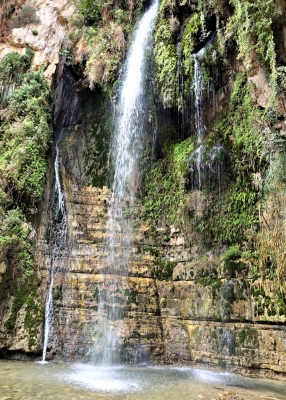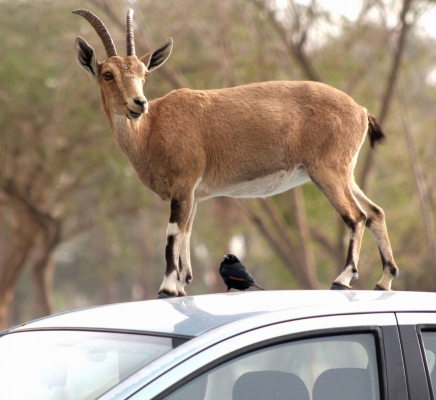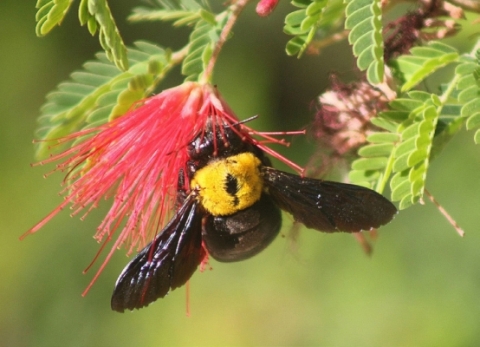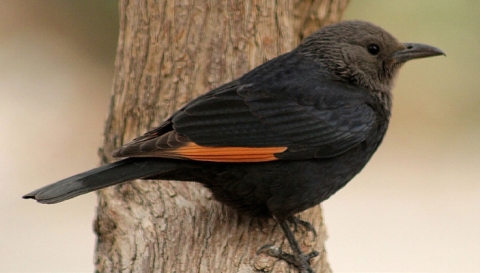Nature of Ein Gedi
My beloved to me is a spray of henna blooms from the vineyards of Ein Gedi (Song of Songs 1:14)
Prior to our recent trip to the Dead Sea and Ein Gedi, we hadn't visited the area in years. In the intervening time, the Dead Sea itself suffered considerably and is now much further from the road than it was back then. Water levels are falling at a rate of about a meter per year – a phenomenal statistic – and much of the shoreline is off-limits due to the danger of erratic and terrifying sinkholes in the now-unstable surface. However, despite the significant decline in sea-level, the nature reserve at Ein Gedi is still like a paradise for nature lovers.
We (my wife and I) booked accommodation at the Kibbutz Hotel at Ein Gedi, and immediately on arrival we were delighted to find nature right on our doorstep. We opened the curtains of our room to see Syrian rock hyraxes at play on our terrace. Unobserved by them, we watched the hyraxes chase each other playfully
The hyrax, unrelated to Dr Seuss' Lorax, is a small furry animal also known as the coney or the rock rabbit, but it isn't related to the rabbit either. Its nearest family member in the animal kingdom is, believe it or not, the elephant. It is hard to associate the hyrax, just half a meter long and four or five kilograms in weight, with its much heftier relative, but facts are sometimes much stranger than fiction.
In Hebrew, the Syrian rock hyrax is called a shafan, and its great claim to fame in the Torah, is being listed as one of the unkosher animals (Leviticus 11:5). Just like the camel and hare, it brings up the cud, but doesn't have cloven hoofs. The hyrax is also mentioned by King David in Barchi Nafshi (Psalms 104:18) "the high mountains for the ibexes; the rocks a shelter for the hyraxes".
Long-horned ibexes were also roaming free in the hotel grounds. They were completely oblivious to the people in the locale, wandering around as though they owned the place, which of course, they probably do, by dint of having been there first. The kibbutz, as well as hosting hyraxes and ibexes, is home to a multitude of birds flying happily in the beautiful grounds, which constitute one of the largest botanical gardens in Israel, with exotic and not so exotic trees and shrubs from all over the world. It was particularly interesting to see hosts of carpenter bees swarming over the flowering shrubs and trees. Carpenter bees, as their name implies, busy themselves making holes in the wood of the trees to lay their eggs in a safe environment. Luckily they are unlikely to sting you, unless you try to pick them up.
We spent many happy hours in the neighboring Ein Gedi Nature Reserve, where we hiked to the David Waterfall about 1500 meters from the parking lot. It was much tougher terrain than the 'easy' categorization assigned by the visitors' center, but almost for sure we were walking the paths that King David trod while hiding from King Saul in the strongholds at Ein Gedi (I Samuel 24:1-2).
Hyraxes and ibexes as well as a great variety of birds were in abundance. We saw redstarts and blackstarts and the bright blue-colored sunbirds, as well as assorted raptors gliding above the clifftops. Large numbers of Tristram's grackles, a rather handsome member of the starling family with bright orange tail flashes, flocked towards anyone they thought would feed them.
We were somewhat surprised to return to our car one day, after a wonderfully satisfying hike in the Nature Reserve, to find a full-grown ibex standing on its roof. In the 1960's my father used to drive a Singer Gazelle – now, I shall always think of our car as a Hyundai Ibex. There was no damage done to the car, which is just as well, as we would have struggled to explain to our insurance company that the dents in the roof were a properly kosher claim. Of course, as unkosher as is the hyrax, kosher is the ibex, which both chews the cud and has cloven hooves.
It was certainly a beautiful location that King David chose for his hideout, and we came away from the area feeling refreshed and enchanted.
My wife, Miriam Alper, was so inspired by what we saw at Ein Gedi that she composed a piece of orchestral music that you can listen to on my YouTube channel https://www.youtube.com/user/JulianAlper1.












Comments